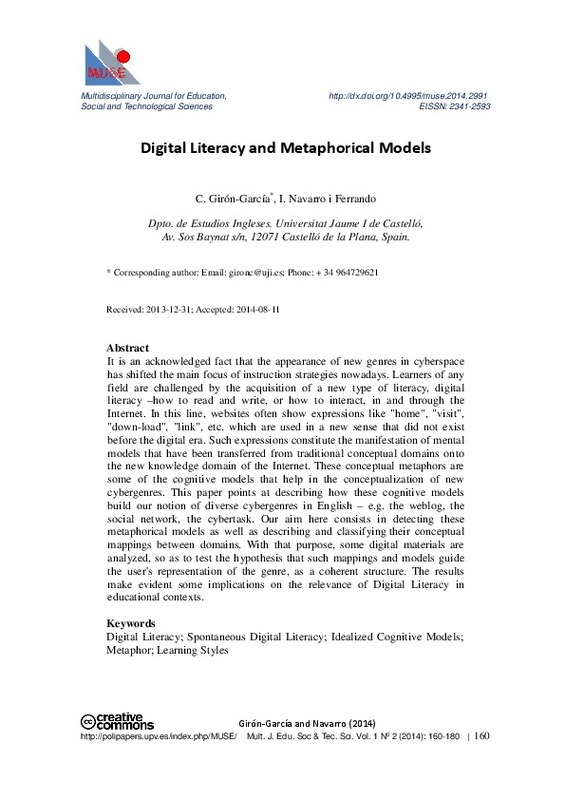Caballero, R. (2003). Metaphor and Genre: The Presence and Role of Metaphor in the Building Review. Applied Linguistics, 24(2), 145-167. doi:10.1093/applin/24.2.145
Dunn, R., and S. Griggs. (1988). Learning styles: Quiet revolution in American sec- ondary schools. Reston, Va.: National Association of Secondary School Principals.
Kress, G. (2004). Literacy in the New Media Age. London: Routledge.
[+]
Caballero, R. (2003). Metaphor and Genre: The Presence and Role of Metaphor in the Building Review. Applied Linguistics, 24(2), 145-167. doi:10.1093/applin/24.2.145
Dunn, R., and S. Griggs. (1988). Learning styles: Quiet revolution in American sec- ondary schools. Reston, Va.: National Association of Secondary School Principals.
Kress, G. (2004). Literacy in the New Media Age. London: Routledge.
Kellner, D. (1997). "Intellectuals, the New Public Spheres, and Technopolitics," New Political Science 41-42 (Fall): 169-188.
Kövecses, Z. (2010). Metaphor. A Practical Introduction, Oxford: Oxford University Press.
Labbo et al. (2003). Teacher wisdom stories: Cautions and recommendations for using computer-related technology for literacy instruction [Electronic version]. Reading Teacher, 57 (3), 300-304.
Luzón, M.J. and Ruiz-Madrid, N. (2008). Learning to learn in a digital context: Language learning webtasks for an autonomising "wreading" competence. Corell.
Luzón, M. J., Ruiz-Madrid, M. N. and Villanueva, M. L. (2009). Students´ Perceptions of Language Learning Webtasks to Develop Electronic Literacy. In Helping people to learn foreign languages: teach-niques and teach-nologies. Universidad Católica San Antonio de Murcia. 156-173.
Navarro, I. (2008) Metaphorical ICMs in cybergenre representation, vol 7, Studia Universitatis Petru Maior. Series Philologia, Targu Mures.167-177.
Navarro, I. and A. J. Silvestre. (2009). The Role of ICMs in Cybergenre Representation and Reading Modes. In M. Navarro Coy (ed.) Practical Approaches to Foreign Language Teaching and Learning. Linguistic Insights 78. Berlin/NY: Peter Lang. 269-292.
Ponterotto, D. (2000). The Cohesive Role of Cognitive Metaphor in Discourse and Conversation. In Barcelona, Antonio (ed) Metaphor and Metonymy at the Crossroads: A Cognitive Perspective. Berlin-New York: Mouton de Gruyter, 283- 298.
Ponterotto, D. (2005). Text, Context and Cognitive Metaphor. In Baicchi, Annalisa et al. (eds) Modelling Thought and Constructing Meaning. Cognitive Models in Interactions. Milano: Franco Angeli, 156- 169.
Schmar-Dobler, E. (2003). Reading on the Internet: The link between literacy and technology. Journal of adolescent and adult literacy, 47(1), 80-85.
Shepherd, M. A., Watters, C. R. and Kennedy, A. (2004). Cybergenre: Automatic Identification of Home Pages on the Web. J. Web Eng., 3(3-4), 236-251.
Shepherd, M., & Watters, C. (s. f.). The evolution of cybergenres. Proceedings of the Thirty-First Hawaii International Conference on System Sciences. doi:10.1109/hicss.1998.651688
Toms, E. G., & Campbell, D. G. (s. f.). Genre as interface metaphor: exploiting form and function in digital environments. Proceedings of the 32nd Annual Hawaii International Conference on Systems Sciences. 1999. HICSS-32. Abstracts and CD-ROM of Full Papers. doi:10.1109/hicss.1999.772652
Villanueva, M. L. et al. (2008). Understanding Cybergenres as Semiotic Artefacts: Meaning and Cognition beyond Standardized Genres. Computers and Composition on line. Amsterdam: Elsevier Publishing.
Van Dijk, T.A. and Kintsch, W. (1983) Strategies of Discourse Comprehension. New York. Academic Press.
[-]








